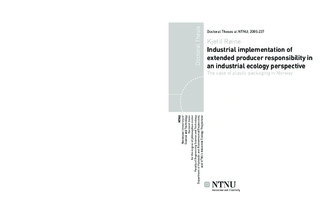| dc.contributor.author | Røine, Kjetil | nb_NO |
| dc.date.accessioned | 2014-12-19T11:25:03Z | |
| dc.date.available | 2014-12-19T11:25:03Z | |
| dc.date.created | 2006-03-10 | nb_NO |
| dc.date.issued | 2005 | nb_NO |
| dc.identifier | 125883 | nb_NO |
| dc.identifier.isbn | 82-471-7377-8 | nb_NO |
| dc.identifier.uri | http://hdl.handle.net/11250/231294 | |
| dc.description.abstract | The purpose of this thesis is to identify key conditions for successful industrial implementation of collective extended producer responsibility (EPR) programmes in the Norwegian plastic packaging system, according to an industrial ecology perspective. ‘Key condition’ is defined as those factors, both drivers and barriers, which are critical for the outcome of industrial implementation of EPR. As we have seen there are several key conditions to be identified. We have studied this by first developing a theoretical framework based on the industrial ecology perspective and combined with a modified understanding on categories for EPR policy instruments we have developed an analytical framework which combines a material flow approach and an actor approach. Based on this we have carried out a case study of the Norwegian EPR system for plastic packaging, organised by the producer responsibility organisation Plastretur. We have shown the complexity of this system by doing analysis on various levels, both with respect to material flows and to actors. Our conclusions are primarily valid for this system only, but we have shown how our results correspond to existing literature, both theoretically and in practice.
The overall conclusion from this case study is that the Plastretur EPR scheme has proven to be successful with respect to recycling ratios and costs, while it has been less successful concerning dematerialisation and design for recycling. This conclusion is contrary to what is considered to be the strength of EPR policies, but it provides empirical evidence for the arguments put forth by for instance Veerman (2004) on the Dutch system, claiming that EPR has mainly effects downstream. We argue that one of the reasons to this controversial result is that previous studies have not to a sufficient extent taken into account the need for identifying the causality between EPR policy instruments and the observed effects. We have provided this through a detailed case study on various analytical levels. | nb_NO |
| dc.language | eng | nb_NO |
| dc.publisher | Fakultet for ingeniørvitenskap og teknologi | nb_NO |
| dc.relation.ispartofseries | Doktoravhandlinger ved NTNU, 1503-8181; 2005:237 | nb_NO |
| dc.title | Industrial Implementation of Extended Producer Responsibility in an Industrial Ecology Perspective | nb_NO |
| dc.type | Doctoral thesis | nb_NO |
| dc.source.pagenumber | 284 | nb_NO |
| dc.contributor.department | Norges teknisk-naturvitenskapelige universitet, Fakultet for ingeniørvitenskap og teknologi | nb_NO |
| dc.description.degree | PhD i industriell økologi | nb_NO |
| dc.description.degree | PhD in Industrial Ecology | en_GB |
